How to Grow Elderberries: It's Super Easy!
Author: Jen Worst | Editor: Omar Alonso
Review & Research: Jen Worst & Chris Miller
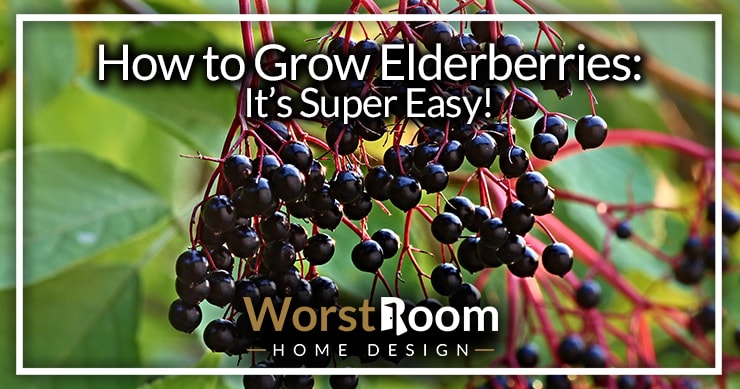
Lots of people want to know how to grow elderberries lately. When compared with blackberries, blueberries, strawberries, and raspberries, elderberries are a much lesser-known fruit.
This is surprising because they have so many benefits. Many people used to consider elderberries to be food only for birds, but things are changing.
Where Do Elderberries Grow?
The elderberry species are native to the continent of North America. To be precise, they're mostly found in the areas present between Canada and Columbia. For this reason, the elderberry family can grow in a variety of climates and conditions.
Elderberries belong to the Sambucus genus, and there are several different types of elderberry plants. However, all its varieties are recognizable due to their large white flowers. These flowers, later, turn into clusters that have many small fruits, which are the growing elderberries.
The most consumed elderberries are purple. However, elderberries are found in many different colors, including blue, black, and red. Be warned that red elderberries, also known as Sambucus racemosa, are poisonous. You must not eat or even touch them, and I suggest against even cultivating them.
When eaten raw, blue and purple elderberries give a bitter and unpleasant taste, but you can process or cook them to make wine, teas, pies, jellies, flavored vinegar, and all types of jam. They're very aromatic in the right types of wine glasses.
How to Grow Elderberries
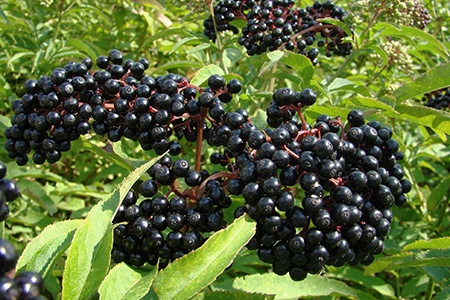
Fortunately, elderberries are the most natural plants to cultivate and a great first choice of the edible berry bushes. You can grow them quickly in your backyard or on a more extensive land. Here is a step-by-step guide for people who wish to grow elderberries.
Step 1: Where to Plant Elderberry Bushes
Choosing a proper location is the first step in planting elderberries.
Elderberry Growing Conditions
Elderberry plants are quite tolerant. They can endure many things, including overly wet areas and poor soil. However, these plants grow the best in partial shade.
Planting elderberries early in the spring is the best practice. In this way, you don't have to worry about frost.
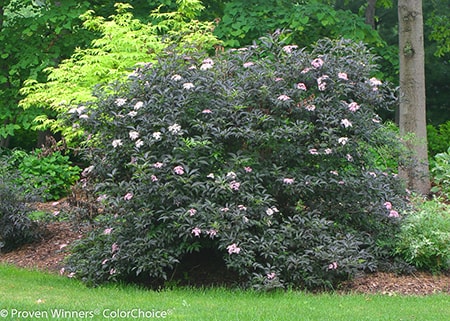
You must plant your elderberries in a cold and moist place instead of a hot and dry one. This is because although elderberries are durable and adaptable, they cannot tolerate drought. Also, for best results, make sure your soil's pH is between 5.5 and 6.6.
Moreover, elderberry plants thrive in a well-drained place that isn't prone to stagnant water. So your planting location must be quickly drained. Otherwise, your plants will be prone to root rot.
Besides, elderberries love loamy soils. So you must make sure your soil is loamy enough for the plant. If your planting place has sandy soil, adding useful organic matter up to a few inches is the solution. Using 10-10-10 fertilizer provides excellent results, or you can compost in early spring every year. Learn more about fertilizer numbers here.
Types of Elderberry Bushes
If you're planting elderberry for its fruit, we recommend you to plant a few different varieties. Many popular types, such as John's and York, are known to produce the right amount of fruit. However, before planting, always check if the variety you're using bears safe and edible fruits or not.
Some types of elderberry include:
- Kent
- Nova
- York
- Johns
- Lacinaiata
- Scotia
- Adams
Elderberry Spacing
Another crucial chance aspect while planting elderberry bushes is the distance between each of your plants. You must leave plenty of space between the two plants. To be precise, elderberry spacing should be 3 to 6 feet apart.
In addition to that, they should be planted in rows that are 4 to 5 feet apart. This is important for a few reasons.
First, it allows air circulation between each pair of shrubs, which prevents diseases that can infect the leaves. Secondly, due to more air circulation, cross-pollination will be better. This is an effective way to produce more fruit. Furthermore, mature elderberry plants need a big space for the best growth. They can grow up to be about 6 feet wide and 12 feet tall.
Step 2: Elderberry Care
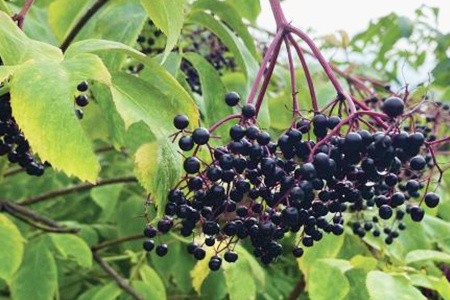
Fortunately, elderberries are easy to maintain. This is why they are so abundantly present in the wild. A grower has to take the most care of them in the first year. After that, they don't need a lot of maintenance. But understand that elderberry bush care starts right after you plant your elderberries.
Watering Elderberry Bushes
You must water them well after planting to give them a good start. Similar to growing other plants, a grower must make sure his elderberries are well-watered throughout all stages of growth.
In the beginning, elderberries need plenty of water. If your soil is quickly drained, you shouldn't worry about overwatering them, but if you have standing, stagnant water, keep this is mind or devise a way to drain the area.
Elderberry plants have shallow roots. Therefore, you must water them thoroughly—especially in the first year after planting. The growing bushes of elderberry plants require about 1 inch of water every week.
So you must make sure they get enough water in one way or another. Using alternatives to underground sprinkler systems can help make this cheap and automated.
Elderberry Fertilization
Fertilization fulfills many requirements of your elderberries. As with most plants, you must fertilize your soil from time to time with compost or manure. After planting, you should feed your soil every year in spring.

If you need an idea of fertilizer quantity, we recommend increasing your 10-10-10 fertilizer dose by 0.5 pounds each year for a single plant. Stop increasing the amount when you reach 4 pounds for a single plant.
Weed Control Around Elderberry Bushes
Growing these lovely bushes requires regular removal of weeds. This process, though, requires a lot of care. Since elderberries have shallow roots, it's easy to disturb them while removing weeds.
To avoid this, we recommend using mulch for weed control or plucking weeds by hand. If you can prevent the existence of weeds, use any valid method that doesn't affect the plant much.
It's not very common for elderberries to be attacked by pests or diseases. However, in wet areas, mildew may attack the plants. Mildew is not so harmful that it destroys the plants, but you should eliminate it for better results. You can remove the mildew by either using a fungicide or destroying the affected parts in autumn.
Pruning Elderberry Bushes
Elderberries do not require frequent pruning. However, if you still want to prune yours, you can prune the oldest canes that aren't productive. You would find such canes three to four years after planting.
It's better if you prune after the end of the season (in winter or early spring) when your plants are dormant. This directs the energy of the plants into new shoots for the upcoming year.
Step 3: Harvesting Elderberries
If you want to get maximum fruit production from your elderberry plants, let them only grow for the first two years.
When to Harvest Elderberries
Under normal circumstances, do not harvest any berries or even prune in these two years.
However, pruning and removing dead areas after this period is beneficial. Doing so will allow your plants to grow more and produce even more berries.
Another important aspect of harvesting elderberries is the harvesting time. Elderberries are ready to be harvested when they appear dark purple or even black. At this stage, the fruit is both juicy and soft.
That being said, if your elderberries appear wrinkled and shrunk at the time of harvest, you're late. They may still be okay for a pie or to make a drink, but if presentation matters you should let the birds have them at this point.
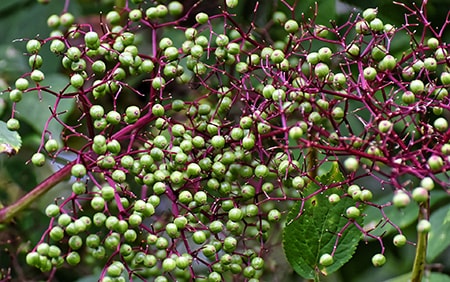
A great way to harvest elderberries is to use a nice pair of pruning shears to cut entire clusters of the berries. You should make your cuts very close to where the fruits begin. This prevents the loss of any extra parts of the plant.
You must also be wary of birds; they love elderberries. If you can prevent birds from entering your garden without affecting your plants, you should do it. If not, you must pick your berries before the birds do.
It's nearly impossible to pick every single berry before they get dried. So it's only logical to get the maximum berries that you can get. To do this, we recommend you to go for clusters that have a lot of berries.
If the berries are close to being ripe, you should pick them. If you find them already mature, you must pick them as soon as possible. Otherwise, the birds will take them all by the next day, and all your hard work will go in vain.
The best time of the year to harvest your elderberries depends on the cultivar that you are growing. However, generally, elderberries are ready to harvest right around August and September. During this time, elderberries go through a ripening period of 5 to 15 days. This period is the perfect time to harvest your elderberries.
Elderberries Cultivation FAQs
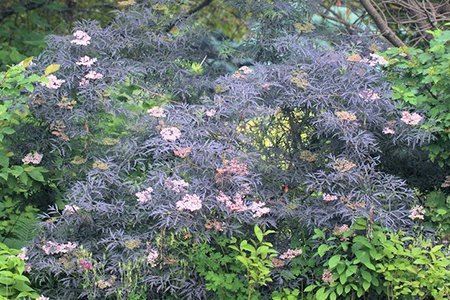
Here are a handful of the most frequently asked questions regarding growing elderberries.
When Do Elderberries Bloom?
Elderberries bloom and are ready to harvest around August and September, including a 5 to 15 day ripening period.
How Big Do Elderberry Bushes Get?
The mature elderberry bush can grow to be up to 6 feet wide and 12 feet tall.
Elderberry Growing Conditions
Elderberries thrive in partial shade, with cold and moist soil, with the soil's pH between 5.5 and 6.6, while being watered in a well drained area with 1 inch of water weekly.
Elderberry Growing Zone
Elderberries grow in the USDA Plant Hardiness Zones of 4 - 7 (though 5 - 7 are the best zones).
Elderberry Spacing
Elderberry bushes should be planted 3 to 6 feet apart. The rows should be 4 to 5 feet apart. This improves air circulation, reduces disease, and improves cross-pollination.
Elderberry Bush Care
Elderberry bushes have shallow roots that need frequent watering of around 1 inch of water per week, but the soil should drain well between waterings. Care should be taken when removing weeds as to not disrupt the shallow roots. Pruning should not occur for the first two years and should start with branches that aren't producing fruit.
Growing Elderberries...
You must be wondering why you should grow elderberries when you can cultivate any other fruit. There are many reasons for this. First of all, elderberries are easy to grow, whereas developing other fruits is much more demanding. More importantly, elderberries have tons of health benefits.
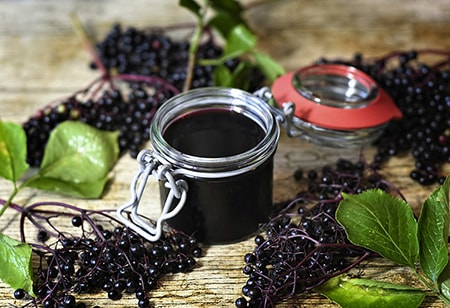
Ripe elderberry fruit is packed with several essential nutrients. First, they are a rich source of Vitamin A and C and have more Vitamin C than even oranges. Many studies have proven that elderberries have a very high amount of flavonoids, tannins, phenols, potassium, and mucilage. Besides, they are a good source of folic acid.
Being such a nutrient-dense fruit, you only need a little amount of these berries to keep your body healthy for the whole year. A great way of consuming elderberries is to make jams and jellies with it. Other than that, you can ferment them into a port-Esque wine. If you don't want to put in a lot of effort, you can boil your berries to make a viscous immunity-booster syrup.
The taste, ease of cultivation, and health benefits are the reasons to learn how to grow elderberries.



